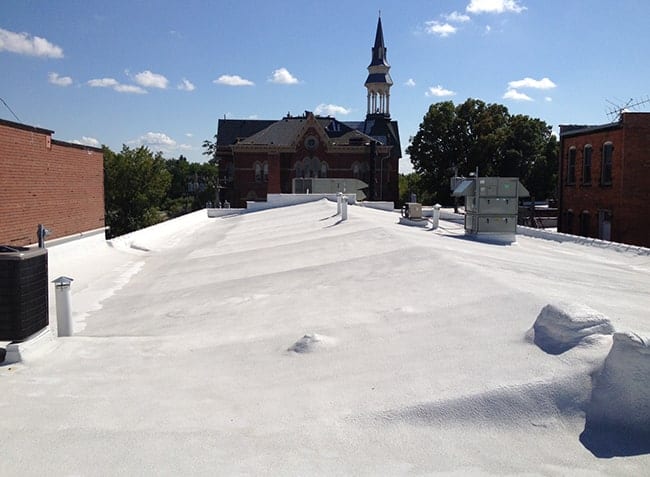So, you’ve noticed a leak in your commercial roof, and you’re wondering what to do next? Call and get it repaired for the 50th time, or is it finally time to fix the problem for good?
Today I want to introduce you to a roofing system most are unfamiliar with, a spray polyurethane foam (SPF, for short) roofing system.
There are many roofing options to choose from. However, one of the most popular reasons companies switch to spray foam is because of energy savings.
Think about it: if you have a black roof in the summer, your roof is hot as can be. Your HVAC unit uses tons of energy to cool down your building (we’ve seen black roofs this summer as hot as 192 degrees F).
And if you have leaks, in the summer, you’re letting cool air escape constantly, and in the winter, you’re letting heat escape constantly.
There you have it, get a quote for an SPF roof now. End of story.
I’m just kidding, you’re going to need more proof than that, let’s dive in…
What is a spray polyurethane foam roof?
A spray polyurethane foam roof is a roofing material that’s sprayed on as a liquid, so it expands into a foam, creating a solid layer across an existing roof.
The closed-cell foam is created by combining and heating two liquids, a polyol/resin and an isocyanate.
As the liquid is sprayed onto the existing roof, it creates a foam that expands 20 times in size to form a solid, seamless foam surface. When the foam has expanded, this layer can be between 1 and 2 inches in thickness.
When the SPF layer has been completed, it’s then coated with a layer of elastomeric silicone or acrylic coating with embedded granules. This layer is generally between 20 and 30 mils (a mil is a thousandth of an inch — .001 inch.) in thickness. The coating protects the foam roof system from UV light, weather, normal wear and provides the required fire ratings.
When the installation is complete, it’ll create a seamless, durable, moisture-resistant, renewable foam roof covering.
SPF has an R-value of 6.6 per sq. in., providing the greatest R-value per square inch of any roofing system.
What does R-value have to do with reduced energy costs?
R-value reduces energy costs because that’s the capacity of an insulating material to resist heat flow. The higher the R-value, the greater the insulating power.
The higher the R-value, the less heat or cool air will pass through. Higher R-value = less HVAC use = lower energy costs.
How does the Spray Polyurethane Foam roofing system save money on your energy bill?
This happens in three ways:
Way #1 – Your building will start off cooler.

If you currently have a black roof, with a new white/light-ish gray-colored roof coating that goes over spray foam, your roof will now be considered a cool roof.
By changing the color, we’ve seen a difference of 50 degrees Fahrenheit on the exact same roof. A lower temperature on the roof reduces the amount of work an HVAC unit will have to do to produce a comfortable temperature inside the building.
Way #2 – With spray foam, you’ll have a monolithic, airtight roofing system.
Airtight!
However, nothing can resist heat or cool air forever. That cold beer in your Yeti cooler will not be cold one year from now.
But with a spray foam roof having the highest resistance to heat flow, it’ll do the best job possible of keeping the cool air in your building in the summer, and the heat in during the winter.
Way #3 – Your HVAC unit will have less wear and tear.
With the heat/cool staying in, the HVAC unit won’t have to work as hard to maintain temperature.
So, does this really work? Let’s look at a few examples of how an SPF roof reduced energy costs.
Flying J Truck Stop/Restaurant
Flying J in Virginia had a ballasted EPDM roof. We removed the rock, put down a cover board, and sprayed 1.5” of foam. We coated the foam roof with 20mils of silicone.
Flying J was saving $1700/mo. after putting a spray polyurethane foam roof on.
How?
After removing the rock and inserting cover board (increasing insulation), adding in the foam roof and coating, the previous black roof was now white.
Flying J is open 24/7, which means there’s energy being used 24/7. The reflectivity of the new roof, combined with the heightened R-value, greatly reduced Flying J’s energy cost.
Ford Motor Company
This one comes from another roofing contractor, North Central Insulation out of Wisconsin. On their testimonial page, they have a quote about a SPF roofing job they did for Ford:
“In 1990 we chose to re-roof the 900,000 square foot Ford Sheldon Road plant with an SPF roofing system. We are very satisfied with our SPF roof and haven’t experienced any problems or maintenance costs since the installation. We have realized a decrease in energy bills from $876,000 annually to about $412,000.”
– M.M. Forester, Plant Engineer, Ford Motor Company
One-story building in California
The American Chemistry Council, as well as www.whysprayfoam.org, has a PDF that explains that SPF used on a one-story building roof in California could save the building owner more than $11,000 per year.
Finishing touches on spray foam roofing and energy savings
So, there you have it. A project from us, a project from another roofing contractor, and an announcement from The American Chemistry Council.
However, every roof is different.
If your objective is to get a reliable roof that can save on your energy costs, look no further than a spray polyurethane roof.


